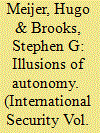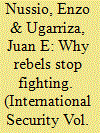|
|
|
Sort Order |
|
|
|
Items / Page
|
|
|
|
|
|
|
| Srl | Item |
| 1 |
ID:
177842


|
|
|
|
|
| Summary/Abstract |
Military operations lie at the center of international relations theory and practice. Although security studies scholars have used campaign analysis to study military operations for decades, the method has not been formally defined or standardized, and there is little methodological guidance available for scholars interested in conducting or evaluating it. Campaign analysis is a method involving the use of a model and techniques for managing uncertainty to answer questions about military operations. The method comprises six steps: (1) question selection, (2) scenario development, (3) model construction, (4) value assignment, (5) sensitivity analysis, and (6) interpretation and presentation of results. The models that scholars develop to direct analysis are significant intellectual contributions in their own right, and can be adapted by other scholars and practitioners to guide additional analyses. Careful model construction can clarify, but does not obviate, the uncertainty of conflict. To manage uncertainty in parameter values, scholars can use the “input distribution approach” to propagate uncertainty in inputs through to a model's output. Replications and extensions of Wu Riqiang's 2020 analysis of Chinese nuclear survivability and Barry Posen's 1991 analysis of the North Atlantic Treaty Organization's prospects against the Warsaw Pact illustrate the six steps of campaign analysis, the value of transparent models and the input distribution approach, and the potential of campaign analysis to contribute to policy and theory.
|
|
|
|
|
|
|
|
|
|
|
|
|
|
|
|
| 2 |
ID:
177841


|
|
|
|
|
| Summary/Abstract |
Europe's security landscape has changed dramatically in the past decade amid Russia's resurgence, mounting doubts about the long-term reliability of the U.S. security commitment, and Europe's growing aspiration for strategic autonomy. This changed security landscape raises an important counterfactual question: Could Europeans develop an autonomous defense capacity if the United States withdrew completely from Europe? The answer to this question has major implications for a range of policy issues and for the ongoing U.S. grand strategy debate in light of the prominent argument by U.S. “restraint” scholars that Europe can easily defend itself. Addressing this question requires an examination of the historical evolution as well as the current and likely future state of European interests and defense capacity. It shows that any European effort to achieve strategic autonomy would be fundamentally hampered by two mutually reinforcing constraints: “strategic cacophony,” namely profound, continent-wide divergences across all domains of national defense policies—most notably, threat perceptions; and severe military capacity shortfalls that would be very costly and time-consuming to close. As a result, Europeans are highly unlikely to develop an autonomous defense capacity anytime soon, even if the United States were to fully withdraw from the continent.
|
|
|
|
|
|
|
|
|
|
|
|
|
|
|
|
| 3 |
ID:
177844


|
|
|
|
|
| Summary/Abstract |
In 2013, the U.S. government announced that its nuclear war plans would be “consistent with the fundamental principles of the Law of Armed Conflict” and would “apply the principles of distinction and proportionality and seek to minimize collateral damage to civilian populations and civilian objects.” If properly applied, these legal principles can have a profound impact on U.S. nuclear doctrine. The prohibition against targeting civilians means that “countervalue” targeting and “minimum deterrence” strategies are illegal. The principle of distinction and the impermissibility of reprisal against civilians make it illegal for the United States, contrary to what is implied in the 2018 Nuclear Posture Review, to intentionally target civilians even in reprisal for a strike against U.S. or allied civilians. The principle of proportionality permits some, but not all, potential U.S. counterforce nuclear attacks against military targets. The precautionary principle means that the United States must use conventional weapons or the lowest-yield nuclear weapons that would be effective against legitimate military targets. The law of armed conflict also restricts targeting of an enemy's leadership to officials in the military chain of command or directly participating in hostilities, meaning that broad targeting to destroy an enemy's entire political leadership is unlawful.
|
|
|
|
|
|
|
|
|
|
|
|
|
|
|
|
| 4 |
ID:
177843


|
|
|
|
|
| Summary/Abstract |
For much of human history, water was a standard weapon of war. In the post–World War II period, however, nation-states in international conflict have made concerted efforts to restrain the weaponization of water. Distinct from realist and rationalist explanations, the historical record reveals that water has come to be governed by a set of intersubjective standards of behavior that denounce water's involvement in conflict as morally taboo. How did this water taboo develop, and how does it matter for nation-states? Focused process-tracing illuminates the taboo's development from the 1950s to the 2010s, and indicates that (1) a moral aversion to using water as a weapon exists; (2) this aversion developed through cumulative mechanisms of taboo evolution over the past seventy years; and (3) the taboo influences states at both an instrumental level of compliance, and, in recent decades, a more internalized level. These findings offer new avenues for research and policy to better understand and uphold this taboo into the future.
|
|
|
|
|
|
|
|
|
|
|
|
|
|
|
|
| 5 |
ID:
177845


|
|
|
|
|
| Summary/Abstract |
Desertion, or the unauthorized exit from an armed group, has major implications for counterinsurgency, war termination, and recruitment dynamics. While existing research stresses the importance of individual motivations for desertion, organizational decline, in the form of military and financial adversity, can also condition desertion. Organizational decline undermines a group's instruments to channel individual preferences into collective action. These instruments include selective incentives, ideological appeal, and coercion. When the binding power of these instruments diminishes, individual desires start to dominate behavior, making desertion more likely. The Revolutionary Armed Forces of Colombia (FARC) insurgency is used to examine this argument with a multimethod approach. First, a quantitative analysis employs unique data on more than 19,000 reported FARC deserters from 2002 to 2017, provided by the Colombian Ministry of Defense. Guarding against threats to causal inference, statistical analysis indicates that organizational decline drives desertion. Second, a qualitative analysis uses a large body of detailed reports on interviews with deserters conducted by Colombian military personnel. The reports demonstrate that organizational decline weakens selective incentives, group ideology, and a credible coercive regime, and fosters desertion through these mechanisms. These findings provide key insights for policymakers, given that desertion can both contribute to ending conflict and accelerate the recruitment of new combatants.
|
|
|
|
|
|
|
|
|
|
|
|
|
|
|
|
|
|
|
|
|